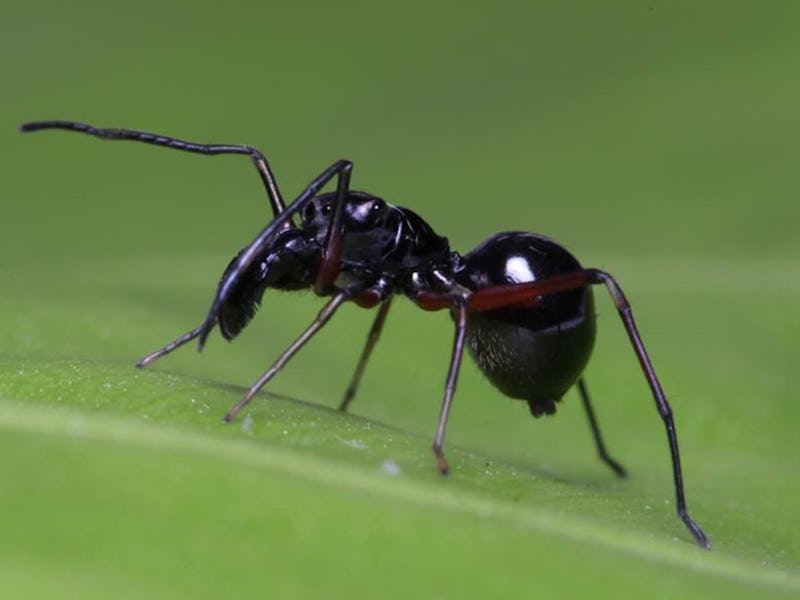Large Adult Spider Sons Can't Get Enough of Their Mommy’s Nutritious Milk
Gross.

Millennials get a bad rap for living with their parents into adulthood, but maybe now jumping spiders will take the heat. Not only do they live at home until they’re nearly adults, but they nurse from their mothers the whole time, too. That’s right: These large adult spider sons love their spider mom’s spider milk so much they don’t move out until they’re almost grown. And while we might usually associate milk with mammals like humans and cows, milk production doesn’t make mammals as special as we might like to think. Even cockroaches produce milk — and apparently it’s good for you. Research published Thursday on a species of black ant-mimicking jumping spider (Toxeus magnus) in the journal Science shows that these young spiders feast on mama’s milk, which is crucial for their early survival and development.
In the paper, a team of researchers in China describe how T. magnus produces milk containing about four times as much protein as cow’s milk, which its offspring feed on for almost 40 days, when they reach the “subadult” stage. At that point, they’re sexually mature, but if reaching sexual maturity doesn’t stop millennial humans from moving out, why should it stop spiders?
This research adds spiders to the list of non-mammals who feed their young some kind of “milk,” along with pigeons, emperor penguins, flamingos, and of course, cockroaches. Almonds, unfortunately, do not make that list.
The offspring of T. magnus stick around for more than a month, drinking milk secreted by the mother (indicated by the red star). A and B show the breeding nest, C shows 1-week-old juveniles sucking milk droplets, D shows 3-week-old juveniles sucking milk from the mother, E shows 5-week-old juveniles and the mother, F shows 7-week-old juveniles (subadults) and the mother, G shows 9-week-old offspring (sexually mature) and the mother, and H shows 11-week-old offspring and the mother.
“Finding such mammal-like behavior in a spider, or in any invertebrate for that matter, was a surprise,” Richard Corlett, Ph.D., a professor of conservation biology at the Chinese Academy of Sciences and one of the study’s co-authors, told The New York Times. “We think that it may reflect the high risk of juvenile spiders becoming prey themselves if they have to hunt for their own food,” he added.
Zhanqi Chen, Ph.D., a postdoctoral researcher at the Chinese Academy of Sciences and the first author on the paper, initially got curious when he noticed that the offspring of T. magnus took a long time to leave the nest. The prolonged adolescence made him suspect that mothers may be providing their offspring with some essential care that kept them around. In addition to the protection that Corlett suggested, observations revealed that the mothers also provide nutritious milk that helps their young stick around safely until they’re big enough to fend for themselves. Early on, the mother leaves little beads of the liquid around the nest, and later on, the young suckle directly from her abdomen.
A species of jumping spider, T. magnus usually uses its ability to avoid becoming prey, but the large adult sons and daughters still hang around their mother for an average of 38 days, even though they can forage on their own at 20 days.
And it turns out the milk is not just a matter of providing a convenient meal. When the researchers covered the mother’s “epigastric furrow” — where the milk comes from — with correction fluid aka Wite-Out, all the hatchlings died within 11 days. The results of this experiment indicate that the milk is, in fact, crucial for the offspring’s survival.
In another experiment, when spiderlings were deprived of milk later on in their development, they did not die off in the same way. Nonetheless, the study’s authors propose that at that point, lactation is probably more about safety than nutrition.
This jumping spider produces a milk so nutritious that its large adult children don't want to stop drinking it.
“In nonmammals, we suggest that the most important ecological conditions favoring the evolution of lactation might be predation risk and uncertain food access,” they wrote. “As a response, the mother’s physiology, behavior, and cognition might have changed to adapt to providing milk and prolonged maternal care as in mammals.” And since the environmental pressures that led to lactation are similar to those that led to it in mammals, why shouldn’t invertebrates develop the habit too?
Joshua Benoit, Ph.D., an assistant professor at the University of Cincinnati who was not involved with the study, told Gizmodo that the study suggests we rethink the way we talk about nursing. Despite being a trait we often associate with mammals, 95 percent of Earth’s species are invertebrates.
“Production of milk-like system may have evolved more times in invertebrate systems than in vertebrates,” said Benoit.